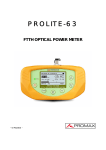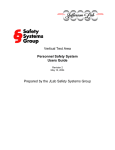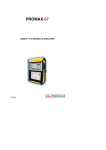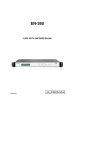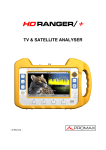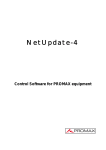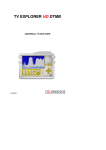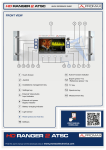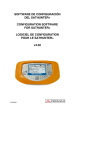Download RM-404 user manual
Transcript
RM-404 MONITORING AND WARNING ALARMS PROGRAM FOR TERRESTRIAL, CABLE AND SATELLITE TV. (TV EXPLORER SERIES). - 0 MI1980 - USER’S MANUAL. RM-404. T A B L E O F C O N T E N T S GENERAL........................................................................................1 1.1 General description .....................................................................1 1.2 Specifications .............................................................................1 1.3 Requirements hardware and software ...........................................5 1.4 Installation ................................................................................5 1.4.1 Software Installation ..............................................................5 1.4.2 Legal conditions.....................................................................6 1.5 Connection between TV EXPLORER and the PC. ..............................7 2 INSTRUCTIONS TO USE THE RM-404 CONTROL SOFTWARE .....................8 2.1 Start .........................................................................................8 2.2 Menu Bar...................................................................................9 2.2.1 File ....................................................................................10 2.2.2 Model .................................................................................10 2.2.3 Report................................................................................11 2.2.4 Test Point ...........................................................................12 2.2.5 View ..................................................................................15 2.2.6 Configuration ......................................................................16 2.2.7 Language............................................................................20 2.2.8 Help ...................................................................................20 2.3 Steps for Monitoring - Toolbar ....................................................21 1 USER’S MANUAL. RM-404. USER’S MANUAL. RM-404. MONITORING AND WARNING ALARMS PROGRAM FOR TERRESTRIAL, CABLE AND SATELLITE TV (TV EXPLORER SERIES). 1 GENERAL 1.1 General description This program is a software application developed to allow communicating a computer and a field meter belonging to the TV EXPLORER SERIES This program allows you to monitor in real time measures that the field meter is obtaining and to store them in a PC. Next some of the most important functions are detailed: • • • • • 1.2 Analyse the performance of signals as time goes by. Control signals through alarms in order to keep them within optimal parameters. Warnings by means of electronic mail about any message of alarm. Generate different reports with the content obtained from monitoring. Automatic report sending to the electronic mail. Specifications The program offers some possibilities in order to analyse different types from signals and modulations available at the present time in TV systems (Terrestrial and Satellite). The frequency range varies depending on the equipment you have: MODEL TV EXPLORER TV EXPLORER TV EXPLORER TV EXPLORER 06/2013 II II+ HD HD+ 5 MHz — 860 MHz YES 5 MHz — 1000 MHz YES YES YES 950 MHz — 2150 MHz YES YES YES YES Page 1 USER’S MANUAL. RM-404. SYSTEMS THAT CAN BE MONITORED TV EXPLORER II / TV EXPLORER II+ TV EXPLORER HD TV EXPLORER HD+ Page 2 ANALOGUE Pal BG Pal DK Pal I Pal M Secam L Secam BG Secam DK NTSC M FM Satellite Pal BG Pal DK Pal I Pal M Secam L Secam BG Secam DK NTSC M FM Satellite TV EXPLORER HD ATSC Satellite NTSC M FM Palm TV EXPLORER HD ISDB-T Satellite FM Pal M NTSC M TV EXPLORER HD DTMB Pal BG Pal DK Pal I Pal M Secam L Secam BG Secam DK NTSC M FM Satellite DIGITAL DAB DVB-T DVB-H DVB-C DVB-S DVB-S2 DAB DVB-T DVB-T2 DVB-H DVB-C DVB-S DVB-S2 J83 8VSB DVB-C DVB-S DVB-S2 DSS ISDB-T DSS J83 DVB-C DVB-S DVB-S2 DAB DVB-C DTMB J83 DVB-S DVB-S2 DSS 06/2013 USER’S MANUAL. RM-404. MEASURES THAT CAN BE MONITORED ANALOGUE Terrestrial: TV EXPLORER II / TV EXPLORER II+ TV EXPLORER HD LEVEL C/N V/A DESV FM Satellite: LEVEL C/N DIGITAL Terrestrial: POWER C/N MER CBER VBER Satellite: POWER C/N MER CBER VBER LBER Terrestrial: Terrestrial: TV EXPLORER HD+ LEVEL C/N V/A DESV FM Satellite: LEVEL C/N Terrestrial: TV EXPLORER HD ATSC LEVEL C/N V/A DESV FM POWER C/N MER CBER VBER Satellite: POWER C/N MER CBER VBER LBER Terrestrial: POWER C/N MER SER CBER VBER Satellite: Satellite: LEVEL C/N 06/2013 POWER C/N MER CBER VBER LBER Page 3 USER’S MANUAL. RM-404. MEASURES THAT CAN BE MONITORED ANALOGUE DIGITAL Terrestrial: Terrestrial: LEVEL C/N V/A DESV FM POWER C/N MER SER CBER VBER Satellite: Satellite: LEVEL C/N POWER C/N MER CBER VBER LBER Terrestrial: TV EXPLORER HD ISDB-T Terrestrial: TV EXPLORER HD DTMB ALARM CONFIGURATION IN: Page 4 LEVEL C/N V/A DESV FM POWER C/N MER SER CBER VBER Satellite: Satellite: LEVEL C/N POWER C/N MER CBER VBER LBER ANALOGUE DIGITAL TV EXPLORER II / TV EXPLORER II+ TV EXPLORER HD LEVEL C/N V/A TV EXPLORER HD ISDB-T/ATSC/DTMB LEVEL C/N V/A POWER C/N MER CBER VBER LBER POWER C/N MER CBER VBER LBER SER 06/2013 USER’S MANUAL. RM-404. 1.3 Requirements hardware and software In order to use the program, your computer must fulfil the following requirements: 1.4 • Personal compatible computer Pentium or higher. • Compatible operating systems: Windows 98, Windows XP, Vista Windows, and Windows 7. • Screen Resolution 1280 x 800 for a correct display. • 23 MB of space available in the hard disk. • Puerto USB available. Installation 1.4.1 Software Installation The RM-404 install file is provided in a memory support (pen drive or CD-ROM) or can be download from the page “Firmware and Software” at the "Download" area in the PROMAX Web page (www.promaxelectronics.com). Find the file (setup.exe) and start installation following these steps: 06/2013 1. Double click on the file to run it. 2. Follow the instructions installation process. 3. The install program creates, by defect, a folder in C:\ Program files \ PROMAX \ RM404 where it copies the program files and the folder “Database”, this is the folder where, by defect, a set of folders are copy in order to store all data files. It also creates a shortcut to the program in the desk and in “Start \ All Programs \ PROMAX \ RM404”. 4. To run the program click twice on the icon of direct access RM404 that is in the desk. that will guide you during the Page 5 USER’S MANUAL. RM-404. 5. In the section “Instructions to use” the program operation is explained with detail. 1.4.2 Legal conditions Read the contract carefully in its entirety before you install the program. Installing the program means that you have accepted the following terms and conditions. 1. SUBJECT. The subject matter of this Contract is the grant to the end user by PROMAX ELECTRONICA, S. L. a non-exclusive and nontransferrable personal license to use this version of the program for an indefinite period of time. 2. LICENCE. The Licence of Use granted hereby refers exclusively to the end user, who shall be considered legitimised to use the program only. 3. OWNERSHIP OF THE SOFTWARE. The end user acknowledges that the program referred to in this Contract is the exclusive property of PROMAX ELECTRONICA, S. L. The end user may only acquire the personal and non-transferrable right to use the software that is the subject matter of this Contract for the purposes herein expressed. Since the program granted is protected by industrial and intellectual copyright, infringements by the user of these aforementioned obligations will give rise to the corresponding liabilities in accordance with the legislation in force. 4. RESOLUTION. The licence or authorisation of use is granted for an indefinite period of time. However, in the event of non-compliance by the end user with any of the clauses hereof, the Contract may as of right be terminated without any legal formality. 5. EXPLANATORY PROVISION. Not with standing the accuracy of the software granted, PROMAX ELECTRONICA, S. L. is fully exempt of liability for consequences arising from any possible omission existing in the program or from improper use by the end user of any of the information it contains and generates. Nor can PROMAX ELECTRONICA, S. L. be held liable for the suitability or accuracy of the data obtained for particular purposes or functions, since the only obligation of the latter, under this Contract, is the provision of means and not of results. 6. FINAL CLAUSE. The use of this software referred to herein signifies the tacit and unconditional acceptance of its conditions. Page 6 06/2013 USER’S MANUAL. RM-404. 7. JURISDICTION. Both parties, explicitly waiving any rights that may correspond to them, agree to submit all controversies that may arise from this Contract to the jurisdiction and competence of the Judges ad Courts of Barcelona. 1.5 Connection between TV EXPLORER and the PC. The TV EXPLORER and the PC is connected by means of the USB cable data transmission that is provided with the equipment. Connect an end to a free USB port at the PC. Connect the other end to the mini-USB port located at the back of the meter. Figure 1.- Connection between TV EXPLORER and PC. If the communication between the program and the meter does not work, maybe is because the USB driver for the communication of PROMAX devices has not been installed. This driver can be downloaded from the page “Firmware and Software” at the download area in the PROMAX web page (http://www.promaxelectronics.com/). 06/2013 Page 7 USER’S MANUAL. RM-404. 2 INSTRUCTIONS TO USE THE RM-404 CONTROL SOFTWARE Start 2.1 Follow the next steps to start using the RM-404 program: 1. Check the TV EXPLORER is ON. 2. Check the connection cable computer is well connected. 3. Double click on the icon RM-404 at the desk to run the program. 4. It appears the main window of the program (see figure below). between TV EXPLORER and Figure 2.- RM-404 Main Window. The main window has a menu bar at the top. Below this, there is a toolbar with some icons, which are enumerated according to the steps to follow in a monitoring process. Occupying the most of the main window there is a grey area where the tables with monitoring data are shown. 5. Page 8 Follow the steps by order to start the monitoring process (see section "Steps for monitoring"). 06/2013 USER’S MANUAL. RM-404. LEGAL NOTE In any case PROMAX ELECTRONICA, S. L. responsible for data loss or other damages that may cause this program directly or indirectly. Although we put our efforts in developing a useful and reliable product, it is understood that the use of the program and data and information generated with it are the sole responsibility of the user. 2.2 Menu Bar Options on the menu bar are: File: It contains options to manage and quit the program. Model: It allows you to select the transmission standard: DVB, ATSC, ISDB-T or DTMB. Report: It allows you to open or create a report table. Test Point: It contains the options to create or edit test points in order to be monitored. View: It contains the options to view the tables. Config.: It contains several options to configure. Language: It allows you to select the program language between English and Spanish. Help: It contains the options to access the user’s manual and the license option. Next sections explain each one of these menus. 06/2013 Page 9 USER’S MANUAL. RM-404. 2.2.1 File Options on the File menu are: - Open report. - Report Viewer. - Save Test Point Set. - Exit. The option Open Report opens a window from where it is possible to recover a report previously created (QRP format), to view data generating a report “per time” and to print it. The option Report Viewer generates a report from data taken from the opened Table Report. The type of view can be: - Min / Max / Avg: This report shows the average, minimum and maximum value of all acquisitions made. - By Time: This report shows all measures based on time. - By Test Point: This report shows all measures grouped by test point. - By Alarm: This report shows all measures out of limit. The option Save Test Point Set allows you to save the table with the test points in a file with extension “*.db” and the name that the user assigns to it. When the test point table is modified, there is necessary to use this option to save changes made. The option Exit closes the program (without confirmation). 2.2.2 Model It allows you to select between the three worldwide standards for digital television transmission: - DVB. - ATSC. - ISDB-T. - DTMB. Page 10 06/2013 USER’S MANUAL. RM-404. If the meter is connected to the computer and communication with the program is done, the program will automatically detect the standard transmission to which the meter belongs. On the contrary the user should select it manually. 2.2.3 Report Options on the Report menu are: - New Table Report. - Open Table Report. - Export to .csv A Report Table is a new table that gathers the data that the meter will take during the monitoring process. Afterwards, the report will be based on the report table with these meter data. The option New Table Report allows you to create an empty report table. When clicking on this option a window pops-up in order to assign a name and to save a new file as a report table. By defect it is opened in the folder “Measurements” of the program. This table will contain all the measures being captured since the moment that begins the monitoring process. Data will be recorded in an automatic way. When stopping the monitoring process it will not store any data anymore. Figure 3.- Report Table Example. The option Open Table Report allows the user to open a table of an already existing report. When clicking on this option a window pops-up in order to select a file of a report table that the user wants to open. By defect this window opens in the folder “Measurements”. This table will appear in the viewing window of the program. With this table a report “per time” will be able to be generated. 06/2013 Page 11 USER’S MANUAL. RM-404. The option Export to. csv exports data from the Table Report to a file with csv extension. The CSV format is an open format to represent data in tabular form, where the columns are separated by a semicolon and the rows by a new line. This type of file can be opened with a standard spreadsheet program . 2.2.4 Test Point Options on the Test Point menu are: - Open Test Point Set. - New Test Point Set. - Edit Test Point. - Edit Test Point Table. The Test Points are the points defined by the user so the program measures and monitors them through the meter. The option Open Test Point Set allows the user to open a table of test points already existing. When clicking on this option open a window to select the table file with the test points. By defect it is opened in the folder “TestPoints” of the program. Figure 4.- Example of Table of Test Points. Page 12 06/2013 USER’S MANUAL. RM-404. The option New Test Point Set creates a table of Test Points. This table appears in the program main window. This table has to be filled up with test points (channels or frequencies) to be monitored by the user. This table is filled up through the options available in the program and explained next. Once defined the table it must be saved. The user can make many tables of test points as he wants in order to select later the one that needs. The option Edit Test Points opens a window that allows the user to change the parameters of the point on the selected table. For it the user should follow these steps: 1.- When selecting the option Edit Test Point a window pop-ups to edit a Point of Test. Figure 5.- NOTE: In the case of ISDB-T standard, it also allows selecting layer. 2.- Next the user should select a Test Point from the Test Point Table and press the Edit button. 3.- The window pick up the data of the Test Point selected. Figure 6.- 06/2013 Page 13 USER’S MANUAL. RM-404. 4.- Now the user, by clicking on the field and typing a new value or by selecting it from the dropdown menu, can change the data field. 5.- Once the user has finished the field edition, he has to click on the Insert button. If everything is correct, the new values will replace the previous ones. If any field is unfilled or the new value exceeds the maximum value or it does not reach a certain minimum value, the user receives an error message. The Edit Test Points option opens a window with several options to edit the Test Point table. Figure 7.- Following, each option is explained in detail: The option Add TER access to a database with the more common terrestrial plan channels of several countries. The user should select one of these plan channels. Each plan channel is composed by a list of test points that can be selected and added to the table of test points created by the user. The user can also select standard transmission between analogue and digital. The option Add SAT access to a database with the more common satellite plan channels. The user should select one of these plan channels. Each plan channel is composed by a list of test points that can be selected and added to the table of test points created by the user. The list with all transponders of the different satellites is updated. In the case that the parameters of the transponders change, the user should identify them with the meter (Auto ID key) and to visualize the new parameters, by unfolding the menu that contains the plan channels on the meter (Key D and A). Next the user will be able to modify them in the list that has been created. Page 14 06/2013 USER’S MANUAL. RM-404. The Copy option copies the line selected in the user's test point table in the clipboard memory. The Cut option cuts the line selected in the user's test point table and saves it in the clipboard memory. The Paste option inserts in the user's test point table the test point line saved in the clipboard memory. The same line can be pasted several times. The option Add New adds an empty new line at the end of the user’s table. The option Insert New adds an empty new line upon the selected line of the user’s table. The option Delete deletes the line selected in the table of the user’s table. The option Delete All deletes all the lines of the user’s table. 2.2.5 View Options on the View menu are: - Test Point Table. - Report Table. - Add Test Points From Exploration. The option Test Point Table puts in first plane of the main window the Test Point Table. The option Report Table puts in first plane of the main window the Report Table. The option Add Test Points From Exploration allows the user to recover test points used in the user’s TV EXPLORER meter, by adapting them to a new list of Test Points that work with the monitoring program. To use this option, previously the user must establish communication between the program and the meter through the option "Search COM PORT". 06/2013 Page 15 USER’S MANUAL. RM-404. To do this, first the user has to select band: TER (terrestrial) or SAT (satellite). Next he has to click on the button “Receive Exploration” to download the whole list from the meter. After downloading the user should unfold the “Channels List” and select one. Then click on “Add Channels”. The selected channels will be added to the list of Test Points. In the case of selecting satellite band the user should select suitable values for Low Oscillator and High Oscillator. IMPORTANT The option Add Test Points From Exploration only works with channels plans created by the meter by means of the “Explorer” function. 2.2.6 Configuration Options on the Configuration menu are: - Operating - Mail - Data Report - Monitor Energy Saver - Alarms - GPS - Shutdown The option Operating, allows the user to select between four forms of work: Continuous, Loops, ON/OFF, Cycles or Loop Single Test Point. The Continuous mode works in uninterrupted monitoring until the user stops it by pressing the STOP icon on the toolbar. The Loops mode makes the same measurements over a number of times defined by the user. When it reaches this number it stops monitoring automatically. The ON/OFF Cycles makes measurements according to cycles of work that are defined by the user. The user must enter working time (monitoring time) in the field “Time ON” and the stopping time (not monitoring) in “Time OFF”. A work phase is followed by a stop phase. When finishing the stop phase it begins the work phase again. It will be looping until the user click on the STOP button in the Operation window to stop the process. Page 16 06/2013 USER’S MANUAL. RM-404. The Autoconfiguration alarm option enables the automatic alarms that are defined in the menu Alarms/Auto in the Operating menu. The Loop Single Test Point mode monitors the first test point of the table. The meter will be set during the first cycle and then it will take continuously measures. The Extra delay time for measurement defines an additional waiting time to measure, once the equipment has been configured with the information of the test point (up to 60 seconds). The Time between test points defines a stop time when monitoring between each test point in the table (up to 43200 seconds). The Time between loops defines a stop time when monitoring between each test point table (up to 86400 seconds). The Sending reports option allows sending periodic reports every time interval defined by the user (up to 2880 minutes). The user can also select the type of report or reports to be received (section 2.2.1). When capturing over 200.000 records in continuous mode, the user must modify a parameter within BDE ADMIN. In order to change this parameter the user has to go to the Windows Control Panel and double click on the icon “BDE Administrator” icon, then select the tab “Configuration” and open the folders “Drivers/Native/Paradox”. In the window that appears there are some parameters, and the user should change the parameter BLOCK SIZE (by default to 2048) to the desired value. The maximum record number is 2 billions (2x1012). The option Mail contains two options: E-Mail and Test mailing. In the E-Mail option the user defines the email address at which he wants to receive the program information, as alarms or reports. The user can define up to three different email addresses, a main one and two secondary. He can enable or disable the sending to the secondary emails. It is advisable not to use the e-mail manager program of the user. Otherwise Outlook Express is recommended. The Test Mailing performs a test mailing with the email addresses defined by the user in order to check that they have been configured correctly. In case of using the e-mail manager program of the user, to work without problems the user has to disable the notification for emails sent by other applications from the email manager (see figure). 06/2013 Page 17 USER’S MANUAL. RM-404. Figure 8.- The option Data Report allows the user to define a series of data that will appear in the report, such as the company data, report data, technical data and meter data. The option Alarm allows the user to define several types of alarms based on the value of several parameters, such as CBER, VBER, LBER, etc… There are two ways to set alarms. In Manual mode or in Automatic mode. In Manual mode to set an alarm first the user should select a test point and then edit the values. When the box “Alarm” is ON it enables all the alarms of the selected test point, when is OFF it disables all them. When the box "Mailing" is checked it sends an email when the alarm goes off. It also appears an icon on the toolbar that indicates that this option is checked. If this box is unchecked it will not send any email but it will be stated in the report that the alarm went off. Page 18 06/2013 USER’S MANUAL. RM-404. Figure 9.- In Automatic mode user can define a tolerance for each type of measurement (level, C/N, V/A, MER) and the alarm is automatically applied to all test points of the table when the measurement is above or below the tolerance. The alarm for the type of measure must be ticked in the Activated column. For the automatic alarm system works, it must be ticked the Autoconfiguration alarm option in the Configuration/Operating menu. If not it will work in the manual mode. Figure 10.- The option GPS allows the user to connect a GPS device to the computer to use it as a geo-locator in the measures taken through the meter. The user defines the communication port and the baud rate for the serial port to comunicate with the GPS. Checking the box "Enable the GPS reception" it activates the communication with the GPS. To start the GPS signal searching process you should click on the button "Search signal". To stop the process you should click on the button "Cancel". 06/2013 Page 19 USER’S MANUAL. RM-404. The Shutdown option allows the user to define the date and hour to turn off the computer. When the shutdown function of your PC is activated it appears the icon of a clock on the toolbar. The program will automatically save the data captured before turning off. The user can also select the type of report and the date and hour to send. Reports are saved by default in the folder: “C:\Program\Files\PROMAX\RM404\Database\SaveReports\”. 2.2.7 Language It allows selecting between languages Spanish or English. 2.2.8 Help Options on the Help menu are: - Tutorial. - About. - Buy RM-404. - Insert license. The option Tutorial give you access to the user’s manual in pdf format. The option About sample shows the version number of the software. The RM-404 program has a trial period of 30 days, after which it does not work unless the license is activated. The option Buy RM-404 gives access to a code that has to be provided when purchasing the program in exchange for the activation code of the program. The option Insert license gives access to a window where you must enter the code supplied when purchasing the program. The user should copy the activation code in case of future re-installations. VERY IMPORTANT NOTE The purchased license is for an unlimited period, but restricted to the PC from which the user purchased the code. Page 20 06/2013 USER’S MANUAL. RM-404. 2.3 Steps for Monitoring - Toolbar The toolbar consists of several icons arranged according to the steps for monitoring. They are: Figure 11.- The first step in monitoring is to create or display a table to store measurement data. To create a new table, the user must click on “New Table Report”. In the case that the table had been created previously he must click on “Open Table Report”. Figure 12.- The second step in monitoring is to create or display a table with measurement points or test points to be monitored. In order to create a new table, the user must click on “New Test Point Set”. In the case that the table had been created previously he must click on “Open Test Point Set”. After finishing click on “Save Test Point Set”. Before proceeding to the next step, if the user wants the program to notify in case of problems with a signal, the user should set the alarms for a test point. In order to set the alarm of a test point, first the user should select the test point he wants to control. Then select the option Alarms on the Configuration menu. Next put to ON the “Active” tab and edit the limit values for each measure. For Level, C/N, MER and V/A the user should select the minimum value and the maximum value. To disable an alarm put both values to 0. For CBER, VBER and LBER the user should select the minimum value and the maximum value. To disable an alarm select the option OFF. Repeat the process with each test point you want (ON = Enabled / OFF = Disabled). 06/2013 Page 21 USER’S MANUAL. RM-404. Figure 13.- The third step in monitoring is to establish communication with the meter. Previously, the user must verify that the computer is connected to the meter by means of the USB cable provided. Next click on “Search COM Port” and the program will change to status “DETECTING” until it finds the port of communication with the meter. The program gives a confirmation message and the status will change back to “STOP”. Figure 14.- The fourth step is start monitoring. Clicking on icon PLAY the monitoring process will begin. The program will automatically store the measures collected from the test points to the table report. Page 22 06/2013 USER’S MANUAL. RM-404. To stop the monitoring at any time the user must click on the icon STOP . The monitoring will not stop until the measurement at that moment is finished. Figure 15.- The fifth step is the visualization of the data collected during monitoring. The program is able to generate a report according to the data the user want to see: - Min/Max/Avg The report presents the average, minimum and maximum value of all acquisitions. - By Time: The report will present all measures based on time. - By Test Point: The report presents measures grouped for each test point. - By Alarm: This report shows all measures out of limit. In addition to follow the five steps just described, the user has additional information on the right part of the toolbar, where there is a window with the information of the status and the system hour. Figure 16.- The messages of the state information can be: - STOPPED: When the monitoring process is stopped. - MONITORING: When the monitoring process is working. - SEARCHING COM: When searching for the COM port where the meter is connected. - WAITING: 06/2013 When working in Cycle mode and it is in the OFF phase. Page 23 USER’S MANUAL. RM-404. Page 24 06/2013






























